The Plextor M8Pe (512GB) SSD Review
by Billy Tallis on December 14, 2016 9:00 AM ESTATTO
ATTO's Disk Benchmark is a quick and easy freeware tool to measure drive performance across various transfer sizes.
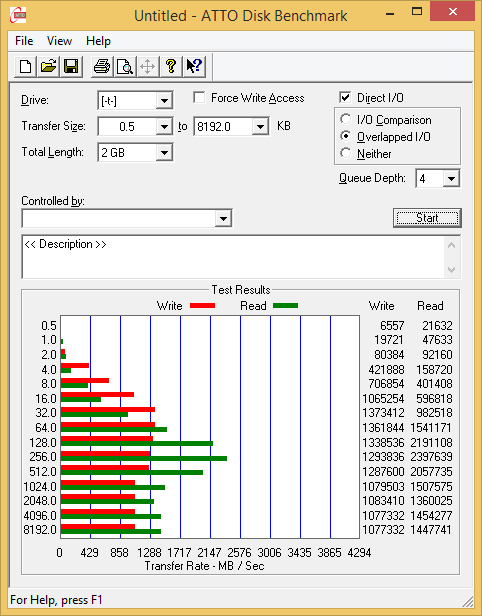 |
|||||||||
The two configurations of the M8Pe ramp up identically as transfer size increases, but the M8PeGN without the heatsink starts throttling right after it hits full performance.
AS-SSD
AS-SSD is another quick and free benchmark tool. It uses incompressible data for all of its tests, making it an easy way to keep an eye on which drives are relying on transparent data compression. The short duration of the test makes it a decent indicator of peak drive performance.
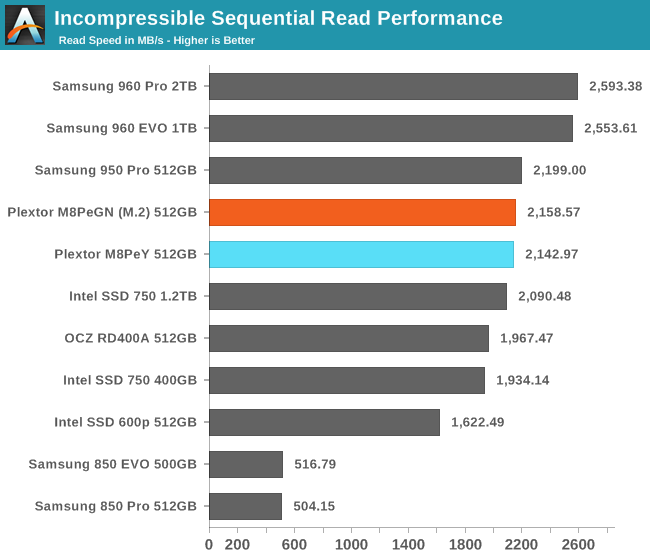
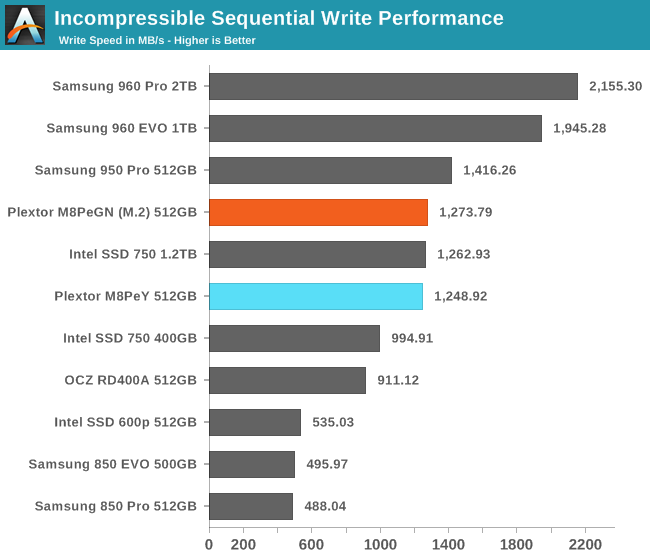
The M8Pe delivers short-duration sequential speeds that are second only to Samsung's PCIe SSDs, and tied with the much larger 1.2TB Intel SSD 750.
Idle Power Consumption
Since the ATSB tests based on real-world usage cut idle times short to 25ms, their power consumption scores paint an inaccurate picture of the relative suitability of drives for mobile use. During real-world client use, a solid state drive will spend far more time idle than actively processing commands.
There are two main ways that a NVMe SSD can save power when idle. The first is through suspending the PCIe link through the Active State Power Management (ASPM) mechanism, analogous to the SATA Link Power Management mechanism. Both define two power saving modes: an intermediate power saving mode with strict wake-up latency requirements (eg. 10µs for SATA "Partial" state) and a deeper state with looser wake-up requirements (eg. 10ms for SATA "Slumber" state). SATA Link Power Management is supported by almost all SSDs and host systems, though it is commonly off by default for desktops. PCIe ASPM support on the other hand is a minefield and it is common to encounter devices that do not implement it or implement it incorrectly. Forcing PCIe ASPM on for a system that defaults to disabling it may lead to the system locking up; this is the case for our current SSD testbed and thus we are unable to measure the effect of PCIe ASPM on SSD idle power.
The NVMe standard also defines a drive power management mechanism that is separate from PCIe link power management. The SSD can define up to 32 different power states and inform the host of the time taken to enter and exit these states. Some of these power states can be operational states where the drive continues to perform I/O with a restricted power budget, while others are non-operational idle states. The host system can either directly set these power states, or it can declare rules for which power states the drive may autonomously transition to after being idle for different lengths of time. NVMe power management including Autonomous Power State Transition (APST) fortunately does not depend on motherboard support the way PCIe ASPM does, so it should eventually reach the same widespread availability that SATA Link Power Management enjoys.
We report two idle power values for each drive: an active idle measurement taken with none of the above power management states engaged, and an idle power measurement with either SATA LPM Slumber state or the lowest-power NVMe non-operational power state, if supported.
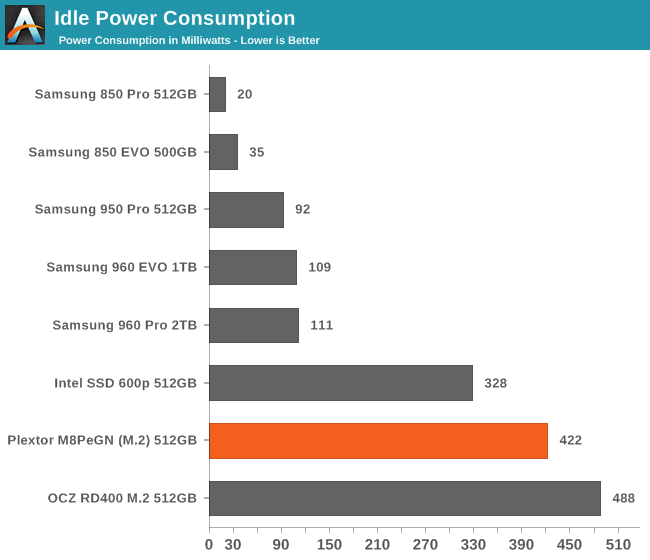
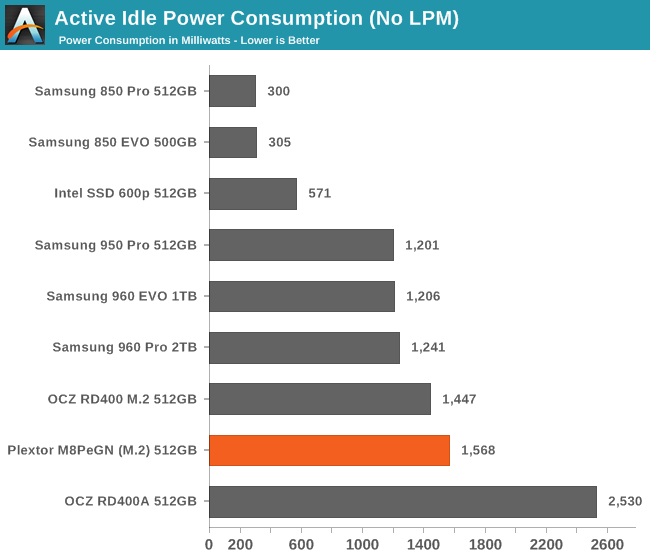
Samsung is still the only PCIe SSD vendor that has made significant progress with idle power management. Even when put into the lowest power state, The M8Pe (and the Intel 600p and OCZ RD400) consume more power than most idle SATA drives with no power saving features engaged.
When NVMe power management is not supported or not enabled, the Plextor M8Pe doesn't look too bad by comparison, as even Samsung's PCIe drives idle at 1.2 W compared to the M8Pe's 1.5 W.










64 Comments
View All Comments
The_Assimilator - Wednesday, December 14, 2016 - link
Conclusion page: the paragraph "The performance differences between the Plextor M8Pe and the Toshiba OCZ RD400..." is repeated. BRO DO YOU EVEN EDITOR?Billy Tallis - Wednesday, December 14, 2016 - link
I think the problem may have been too much editor. My browser was getting really laggy and unresponsive while I was finishing up the article and rearranging things.Threnx - Friday, December 16, 2016 - link
Whoa there are still readers here? hah, I was cleaning out my bookmarks and saw anandtech. You realize all the talent left ages ago right? This site is dead. They're just riding on the name now...cbrownx88 - Friday, December 16, 2016 - link
@Threnx - where do you go now since Anandtech is a shell of its former glory?TemjinGold - Wednesday, December 14, 2016 - link
So... it basically loses across the board to the EVO but they want to charge more for it?Billy Tallis - Wednesday, December 14, 2016 - link
Keep in mind that the 960 EVO results here are for the 1TB model, and that kind of capacity advantage usually brings some performance advantage, too. But yeah, once the 960 EVO is actually shipping in volume, a lot of prices will probably have to come down. Unless the 960 EVO price goes up.close - Wednesday, December 14, 2016 - link
Prices for Samsung SSDs are rising due to the NAND shortage. If Plextor manages to resist this trend they might do well. After all most current workloads don't need anywhere near that kind of level of performance so a slight performance disadvantage is tolerable as long as it's reflected in the price.BrokenCrayons - Wednesday, December 14, 2016 - link
I wasn't aware of a NAND shortage. Do you happen to know the cause?Samus - Wednesday, December 14, 2016 - link
It's simply a supply and demand issue. Other causes are manufacturing process adjustments and lower yield issues often associated with transitioning to new processes.However, the shortage isn't as dire as 'close' makes it seem. Drive prices aren't necessarily increasing because of the shortage, but they aren't falling as they should be with the density improvements associated with TLC and widespread adoption of 3D VNAND. Samsung drives are increasing in price because vendors have noticed sharper demand for them than other drive, and I'm sure you can guess why based on this article alone...I'm not a Samsung fan, but they are currently the most balanced SSD products on the consumer market.
BrokenCrayons - Wednesday, December 14, 2016 - link
Ah that makes sense. Thanks!